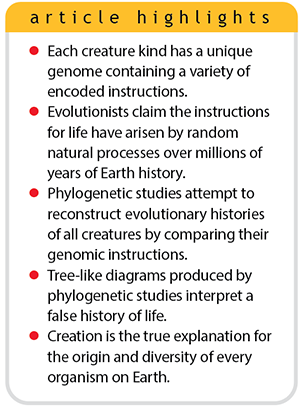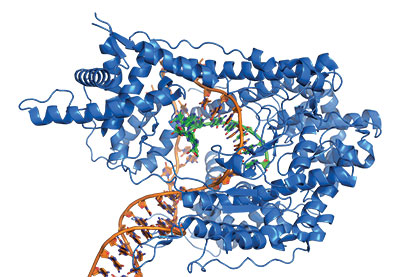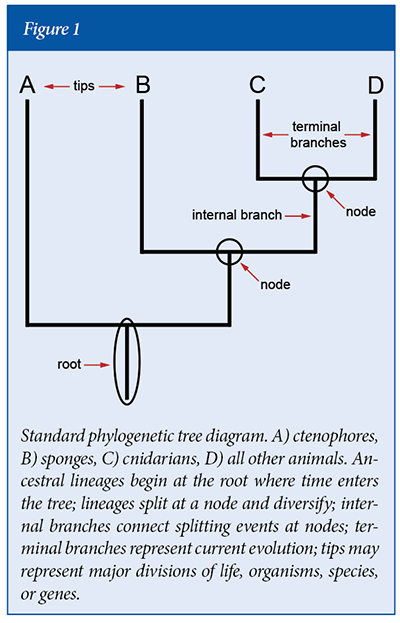Staff Writer
 The instructions to build, maintain, and reproduce every kind of animal on Earth were placed within these organisms when the Lord Jesus created them. The totality of those instructions are called a genome, and they were once thought to be encoded exclusively within deoxyribonucleic acid (DNA) and ribonucleic acid (RNA) molecules.1 However, researchers are uncovering a far more elaborate set of molecular codes that regulate form and function within each division of life (microbes, protists, fungi, plants, animals) and ultimately determine their stunning biodiversity—both past and present.
The instructions to build, maintain, and reproduce every kind of animal on Earth were placed within these organisms when the Lord Jesus created them. The totality of those instructions are called a genome, and they were once thought to be encoded exclusively within deoxyribonucleic acid (DNA) and ribonucleic acid (RNA) molecules.1 However, researchers are uncovering a far more elaborate set of molecular codes that regulate form and function within each division of life (microbes, protists, fungi, plants, animals) and ultimately determine their stunning biodiversity—both past and present.
As the pace of technology increases, the known number and types of encoded instructions also increase. Compared to what we understood just over 20 years ago when the DNA of the human genome was sequenced, we currently find ourselves in awe of an impressive range of coded instructions that manage many interconnected systems in every organism. This inventory includes epigenetic codes; histone codes; genetic codes; alternative genetic codes; regulatory, enhancer, and promotor codes; and both noncoding DNA and RNA molecules with important roles in almost every cell type.1,2
Additionally, where evolutionary biologists once predicted that approximately 2 to 3% of our genome provided functional instructions, it’s now estimated that more than 80% of the human genome participates in at least one biochemical function.1,2
The Current Evolutionary Explanation
According to evolutionary models for the origin and diversification of life on this planet, every molecular code within organisms is believed to have evolved from atoms (e.g., carbon, nitrogen, oxygen) over deep time in a process that began sometime between 4.5 to 3.9 billion years ago.3,4
Furthermore, evolutionary views suggest that every cell type, tissue, organ, and organ system produced from these complex codes came about through numerous trial-and-error changes to DNA and RNA. These changes are commonly characterized as mutations that are assumed to be errors and mistakes that occur during copying and decoding of molecular codes.

More complicated mutations are assumed to occur when individual letters of DNA code (nucleotides) or large stretches of DNA sequence (genes) are lost or gained during reproduction. In the most extensive changes, vast sections of chromosomes or entire genomes are thought to be rearranged or even duplicated, producing multiple copies of genes and/or chromosomes.
Evolutionists envision that the plants and animals that tolerate these changes are somehow selected by nature to survive. And given enough time, their body plans and behaviors become significantly altered from the presumed body plans and behaviors of their ancestors. This mutation-selection process is called Darwinian evolution because it describes the primary mechanism of Darwin’s original theory of evolution and all subsequent revisions. Evolutionary biologists remain convinced that Darwinian evolution is the most informative explanation for the diversity of all extinct and extant life, while they search deeper and deeper into the past for the origin of life itself.
Improbable Origins of Life
Ever since Charles Darwin and Alfred Russel Wallace independently “conceived the same very ingenious theory to account for the appearance and perpetuation of varieties and of specific forms on our planet,”5 there have been repeated efforts to explain the primitive origins of life. This area of investigation is recognized today as origins of life research (OoL). In simple terms, OoL proposes to demonstrate the production of living matter from nonliving matter.6
There are tremendous barriers to the success of such a production. Researchers would need to (1) synthesize and purify all chemical precursors of the four information-rich macromolecules that are essential for life on Earth: nucleotides, amino acids, lipids, and carbohydrates; (2) generate polymers of each macromolecule that are spatially oriented, self-organizing, replicable, and functional; (3) fabricate a self-dividing cell with a phospholipid bilayer that’s interlaced with structural, enzymatic, catalytic, and communicative proteins; (4) establish precise electrostatic properties permitting flow of molecular and chemical information within that cell and between the internal and external cellular environments;6 and the most fundamental barrier of all—(5) produce the information underlying the codes of all living systems that “has never been observed to arise from purely physical or chemical processes.”7
These barriers are only a short list of the fundamental challenges that must be overcome to produce eukaryotic cells, which are the basic functional units of life in fungi, plants, animals, and humans. To date, OoL investigators have never produced de novo (anew) any of the essential macromolecule polymers, any structural or heritable components of a functional cell, or any genetic codes required to specify, maintain, and replicate life.6 Never!
Tree Thinking
Unwavering belief in the natural origin and diversification of life from nonliving matter remains a prominent paradigm worldwide. If only there were an assailable scientific cornerstone upon which the entire evolutionary stronghold teeters.

Well, there is. Interpretations of the origin and diversification of life are dependent upon a singular concept—tree thinking. Specifically, tree thinking refers to the use of phylogenetic (phyl-o, tribe + -geny, production) tree diagrams to graphically “visualize evolution as descent from common ancestors.”8 Different branches within such trees are hypothesized to represent distinct lineages of organisms.
The trees are constructed with computer programs. These programs compare statistical similarities and differences among a highly selective set of protein-coding (amino acids) and noncoding sequences from the genomes of organisms living on Earth today. In the grand scheme, the broadest hypotheses are aimed at resolving deep histories leading to major groups of animals and plants. Or, as Charles Darwin once imagined, “each great kingdom of nature.”9
Following the “Molecular Phylogeny of the Animal Kingdom”10—inferred from a single RNA molecule (18S rRNA)—collaborations have steadily increased the amount of sequence data and diversity of taxa under investigation. Across animals, we now have several published studies on the animal tree of life.11-13 Within animals, there is an arthropod tree,14 molluscan tree,15 annelid tree,16 and mammalian tree,17 with more trees on the way. In almost every case, the primary goal is to reconstruct evolutionary histories of animal form and function from deep time to the present. And time is the key element. As we are told, “the tree is a historical chronicle: the nodes and branches represent ancestral populations that lived at some particular time in the past” (Figure 1).8
So, what do these trees actually show? Of the objects that evolutionary biologists include within a phylogenetic tree, each analysis is limited to showing which objects are more or less similar to each other. However, a major flaw in support of tree thinking is the assumption that similarity relationships represent historical relationships. Without the key element of time, tree thinking could not demonstrate ancestor-descendent relationships. As stated above, the grand scheme of tree thinking attempts to explain the origin and diversification of life from prebiotic chemistry to the entirety of Earth’s biodiversity across history.
Let’s consider an example under intense debate. There are four distinct groups of animals that are thought to comprise the earliest branches in the tree of living animals.12,18 These groups include sponges (Porifera), flat animals (Placozoa), sea anemones and jellyfish (Cnidaria), and comb jellies (Ctenophora). In recent years, phylogenetic reconstructions have promoted two very different arrangements for the position of comb jellies: (1) sponges are the most genetically distant sister group to all other animals,12 with comb jellies and cnidarians sharing a common ancestor; or (2) comb jellies are the most genetically distant sister group to all other animals and thus the “most basal” lineage.12,19 Most recently, chromosome-scale comparisons suggest that ctenophores share genetics with non-animal species and likely diverged first among animals.20
The comb jellies have distinct nerve and muscle cells; sponges do not have these cells. One of two competing interpretations suggests that nerve, muscle, and other complex cell types would have been present in the last common ancestor (LCA) of animals prior to the evolutionary split between comb jellies and sponges. Therefore, sponges have lost these cell types and the genetic architecture that codes for them.
The alternative interpretation is that nervous and other “innovative” cellular systems would have evolved at least twice—once in comb jellies and then in the ancestor of all other animals.19 In other words, genes, cells, tissues, and organ systems may be lost or gained to satisfy the most favorable phylogenetic interpretation.
Such interpretations derive from a comparative alignment of thousands of gene-specific amino acids, chromosome content variation, and a presumed tree-like radiation of most major animal lineages over the past 540 million years.18 This is classic tree thinking: the visualization of evolution as a continuously modifiable tree, which unfortunately today is considered “an essential element of biological literacy.”8
One Tree of Life
From the example above, it’s easy to imagine how molecular phylogenetics has become popular. And as technology advances, tree thinking will continue to grow as a principle application of evolutionary biology.
But is there any truth to it? Are we to believe that the complex molecular instructions of biological life (e.g., epigenetic, genetic, regulatory, noncoding) have been undergoing rearrangement, loss, gain, duplication, doubling, corruption, or other mutational alterations? Should we accept that an unguided, random, error-prone mechanism Darwin called natural selection has been constructing the wondrous diversity of microbes, protists, fungi, plants, and animals? Let’s also remember that the origins of prebiotic chemistry (nucleotides, amino acids, lipids, carbohydrates) and their respective products (DNA/RNA, proteins, phospholipids, sugars) are under the same challenges as the most basic unit of all life—the cell.
Collectively, mankind can scarcely begin to describe the molecular, biochemical, and cellular engineering required to construct one microscopic single-cell organism, let alone a human body, which is comprised of 20 to 40 trillion cells. Undaunted by these facts, evolutionary biologists attempt to reconstruct divergent biological histories that can only show that birds are more similar to birds than they are to bees. They carefully survey the nodes and branches of computer-generated tree-like diagrams and fill in the events that supposedly led from one common ancestor to all descendants that swim, crawl, fly, and walk across the earth today. Regardless, while they insist on gaining insights from these other trees of life, the scientific cornerstone of tree thinking has begun to crumble under the weight of their bold assumptions.
Why does any of this matter? Because there is only one true Cornerstone who created and sustains all life, including the Tree of Life that mankind has been prevented to take from and eat until Christ returns and we join Him in the new Jerusalem (Genesis 3:22; Revelation 22:14).
As the instructions for life continue to surpass the totality of human understanding, we must also continue to recognize our true origin from a common Architect—the Lord Jesus Christ!
References
- Mattick, J. and P. Amaral. 2023. RNA, the Epicenter of Genetic Information: A New Understanding of Molecular Biology. Boca Raton, FL: CRC Press, Taylor & Francis Group.
- The ENCODE Project Consortium. 2012. An integrated encyclopedia of DNA elements in the human genome. Nature. 489: 57.
- Makarov, M. et al. 2023. Early selection of the amino acid alphabet was adaptively shaped by biophysical constraints of foldability. Journal of the American Chemical Society. 145 (9): 5320-5329.
- Higgs, P. G. and N. Lehman. 2015. The RNA World: Molecular cooperation at the origins of life. Nature Reviews Genetics. 16: 7-17.
- Darwin, C. and A. Wallace. 1858. On the tendency of species to form varieties; and on the perpetuation of varieties and species by natural means of selection. Zoological Journal of the Linnean Society. 3 (9): 45-62. Published online July 27, 2011.
- Tour, J. 2019. Time out. Inference: International Review of Science, 4.
- Gitt, W. W., R. W. Compton, and J. A. Fernandez. 2011. Without Excuse. Powder Springs, GA: Creation Book Publishers.
- Baum, D. A. and S. D. Smith. 2012. Tree Thinking: An Introduction to Phylogenetic Biology. Greenwood Village, CO: Roberts and Company Publishers.
- Darwin, C. 1903. Letter to T. H. Huxley, September 26, 1857. More Letters of Charles Darwin. London: John Murray.
- Field, K. G. et al. 1988. Molecular Phylogeny of the Animal Kingdom. Science. 239 (4841): 748-753.
- Philippe, H., N. Lartillot, and H. Brinkmann. 2005. Multigene Analyses of Bilaterian Animals Corroborate the Monophyly of Ecdysozoa, Lophotrochozoa, and Protostomia. Molecular Biology and Evolution. 22 (5): 1246-1253.
- Hejnol, A. et al. 2009. Assessing the root of bilaterian animals with scalable phylogenomic methods. Proceedings of the Royal Society B: Biological Sciences. 276 (1677): 4261-4270.
- Philippe, H. et al. 2009. Phylogenomics Revives Traditional Views on Deep Animal Relationships. Current Biology. 19: 706-712.
- Meusemann, K. et al. 2010. A Phylogenomic Approach to Resolve the Arthropod Tree of Life. Molecular Biology and Evolution. 27 (11): 2451-2464.
- Kocot, K. M. et al. 2011. Phylogenomics reveals deep molluscan relationships. Nature. 477: 452-456.
- Weigert, A. et al. 2014. Illuminating the Base of the Annelid Tree Using Transcriptomics. Molecular Biology and Evolution. 31 (6): 1391-1401.
- Foley, N. M. et al. 2023. A genomic timescale for placental mammal evolution. Science. 380 (6643): eabl8189.
- Dunn, C. W. et al. 2014. Animal Phylogeny and Its Evolutionary Implications. Annual Review of Ecology, Evolution, and Systematics. 45: 371-395.
- Moroz, L. L. et al. 2014. The ctenophore genome and the evolutionary origins of neural systems. Nature. 510: 109-114.
- Schultz, D. T. et al. Ancient gene linkages support ctenophores as sister to other animals. Nature, published online before print May 17, 2023.
















